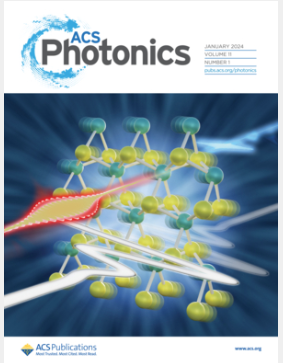Interactions of Light, Surface Plasmons and Excitons in Bilayers of FAPbI3 Nanocrystals with Core–Shell Au/SiO2 Nanoparticles
IF 6.5
1区 物理与天体物理
Q1 MATERIALS SCIENCE, MULTIDISCIPLINARY
引用次数: 0
Abstract
Integration of plasmonic nanostructures into perovskites is an effective way to enhance and tailor light–matter interactions, resulting in further improvement of the already impressive intrinsic photonic properties of the perovskites. Despite remarkable recent progress, the complex mechanisms via which light, excitons and plasmons interact in such hybrid structures are not fully understood. Herein, plasmonic-perovskite structures in bilayer configuration are produced by the deposition of formamidinium lead triiodide (FAPbI3) nanocrystals (NCs) on top of a core–shell gold-silica (Au/SiO2) nanoparticle (NP) underlayer. By tuning the NP core and shell size, a 5-fold enhancement of the macroscopic absorption and luminescence in the vicinity of the localized surface plasmon (LSP) resonance can be achieved in the bilayers compared to reference, pristine FAPbI3 NCs films. Optical spectroscopy performed both at the ensemble and at the few particle level, supported by numerical simulations allow to disentangle the contributions of near-field LSP-exciton and far-field LSP-light interactions that result in the enhancement of the light absorption and light emission. Based on our results, far field light scattering by the LSP results in photon recycling within the perovskite NCs layer, effectively increasing light absorption and light emission. Near-field energy transfer from the metal NPs to the semiconductor NCs contributes less but becomes significant for the case of large core and small shell NPs due to the increased spectral overlap and closer proximity of the surface plasmons and excitons, respectively.

FAPbI3纳米晶体与金/SiO2纳米粒子核壳层间光、表面等离子体和激子的相互作用
将等离子体纳米结构集成到钙钛矿中是增强和定制光-物质相互作用的有效方法,从而进一步改善钙钛矿已经令人印象深刻的固有光子特性。尽管最近取得了显著的进展,但光、激子和等离子体激元在这种混合结构中相互作用的复杂机制尚未完全了解。在此,等离子体-钙钛矿结构的双层结构是通过在核壳金-二氧化硅(Au/SiO2)纳米颗粒(NP)下层沉积三碘化甲醛铅(FAPbI3)纳米晶体(nc)而产生的。通过调整NP核和壳的尺寸,与参考的原始FAPbI3 NCs薄膜相比,双层膜在局部表面等离子体共振(LSP)附近的宏观吸收和发光增强了5倍。在系综和光粒子水平上进行的光学光谱分析,在数值模拟的支持下,可以解开近场lsp -激子和远场lsp -光相互作用的贡献,这些相互作用导致光吸收和光发射的增强。基于我们的研究结果,LSP的远场光散射导致光子在钙钛矿NCs层内回收,有效地增加了光吸收和光发射。从金属NPs到半导体NCs的近场能量转移贡献较小,但对于大核NPs和小壳NPs来说,由于光谱重叠增加和表面等离子体激子和激子的更接近,近场能量转移变得重要。
本文章由计算机程序翻译,如有差异,请以英文原文为准。
求助全文
约1分钟内获得全文
求助全文
来源期刊

ACS Photonics
NANOSCIENCE & NANOTECHNOLOGY-MATERIALS SCIENCE, MULTIDISCIPLINARY
CiteScore
11.90
自引率
5.70%
发文量
438
审稿时长
2.3 months
期刊介绍:
Published as soon as accepted and summarized in monthly issues, ACS Photonics will publish Research Articles, Letters, Perspectives, and Reviews, to encompass the full scope of published research in this field.
 求助内容:
求助内容: 应助结果提醒方式:
应助结果提醒方式:


